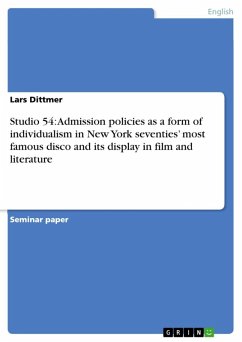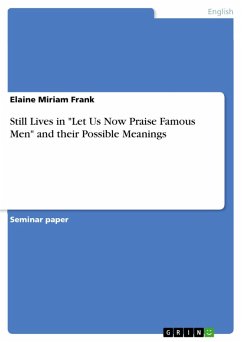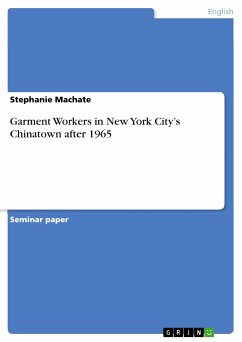Seminar paper from the year 2006 in the subject American Studies - Culture and Applied Geography, grade: 2,0, University of Potsdam (Philosophisches Institut), course: Proseminar, language: English, abstract: "...and for three years it was the most talked-about, written-about and shocked-about venue in the universe. Everyone wanted to go to Studio 54 (Jones/ Kantonen 1999: 246)". "A lot of people thought that at the door was a better show than inside...people would try anything to get in ("Shane" in Studio 54)". When Steve Rubell and Ian Schrager in the late April 1976 started their nightclub Studio 54, a legend came to life. On the floors of this unique party shangri-la, celebrities like Andy Warhol, Liza Minelli, Bianca and Mick Jagger, Brooke Shields and Truman Capote mingled with business people, politicians, soap opera starlets, drag queens and chosen few from the "grey people", as nightlife guru Rubell called the normal people. Never before, a discothèque had caused such a public stir. Paparazzi jostled beyond the velvet ropes to illustrate their gossip columns with pictures of the socialites - it was the "first time ever that celebrity photos would appear on the front page of the tabloids for no other reasons than they were there (Jones/ Kantonen 1999: 249)". But by far not everybody came to know the true promise of the club - door policy at Studio 54 was probably one of the toughest in the history of nightlife. Rubell himself was eager to make sure that of the many different groups that made up the audience of 54, none should dominate the other, a type of "social engineering he called "tossing the salad"" (Shapiro 2005: 201). He himself supported his doorman Marc Benecke selecting the people who could pass the velvet ropes, whilst scores of people shouted Rubell's name begging him to be admitted into the club. On one hand, there were certain criteria, but on the other hand, there was enough leeway for arbitrariness, indeed, it was a highly undemocratic procedure that precisely reflected its place, its period and social circumstances. Disco in the 'uncanny 1970s' not only served to escape reality but also epitomised an increasing drive towards individualism that replaced the ideas of participation and community of the sixties. The doors at 54 were instruments to form a new world with new social ladders and in their radicalism marked a peak in this development.
Dieser Download kann aus rechtlichen Gründen nur mit Rechnungsadresse in A, B, BG, CY, CZ, D, DK, EW, E, FIN, F, GR, HR, H, IRL, I, LT, L, LR, M, NL, PL, P, R, S, SLO, SK ausgeliefert werden.









